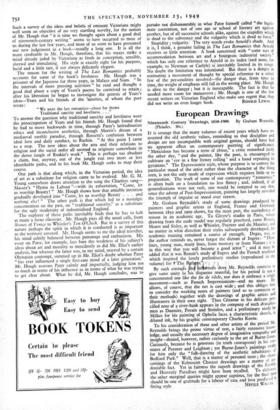European Drawings
Nineteenth Century Drawings, 11150-1900. By Graham Reynolds, (Pleiades. 30s.) Nineteenth Century Drawings, 11150-1900. By Graham Reynolds, (Pleiades. 30s.) IT is strange that the many volumes of recent years which have re- asserted the old aesthetic values, reminding us that discipline and
design are not incompatible with original genius, should have had
no apparent effect on contemporary painting of significance. " Meticulous has become a term of abuse," a critic remarked justly
the other day, "and the painter, like the poet, is encouraged to
cultivate an eye in a fine frenzy rolling' and a hand repeating its gyrations." The Expressionist style, whose purpose is to convey the
particular mood of the artist rather than the character of the thing
seen, is not -the only mode of expression which requires little or no preparation. The work of some of our contemporary "romantics"
is often built on a foundation no less flimsy ; and, indeed, if all -generalisations were not rash, one would be tempted to say that, since the advent of Post-Impressionism, painting has largely revealed the triumph of impulse or mood over reason.
Mr. Graham Reynolds's study of some drawings produced by painters and graphic artists in England, France and Germany
between 1850 and 1900 shows, for the most part, the ascendency of reason in an academic age. To Gleyre's studio in Paris, where drawing from the nude model was regularly practised, came Renoir, Monet and Sisley, as well as Whistler, Poynter and du Mauricr, and no matter in what direction their styles subsequently developed, the academic training remained a source of strength. Degas, t00, ai the author reminds us, never forgot the dictum of Ing,res: "Draw lines, young man, many lines' from memory or from Nature ; it is in this way that you will become a good artist " ; and it may be added that it was Renoir's study Of tIngres and the French tradition which inspired the lovely preliminary studies (reproduced in the volume) for V The Bithesi r , • . By such contact's Inc, infkiences -does Mr. Reynolds contrive to give some unity -to his disparate material, for his period is not concentrated one like the fin de siècle, nor does it embrace a single movement—such as French Impressionism—and no more. He allows, of course, that the net is cast wide ; and this obliges him to consider the working notes of painters (and so to comment on their methods) together with the drawings of graphic artists and illustrators in their own right. Thus Cezanne in his delicate pa- cified note of a river-bank appears in the company of such draughts- men as Daumier, Forain and Steinlen, and a preliminary study by Millais for his painting of Ophelia faces a characteristic sketch, in diluted ink, by his graphic contemporary Charles Keene.
To his consideration of these and other artists of the period Mt. Reynoldsbrings the prime virtue of zest, a fairly extensive know. ledge and usually the necessary degree of imaginative sympathy and insight-denied, however, rather curiously to the art of Burne-Jones- Curiously, because he is generous (in truth courageous) in his esti- mates of Poynter and Leighton ; yet Burne-Jones's paintings evoke for him only the "folk-dancing of the aesthetic inhabitants of Bedford Park." Well, that is a matter of personal taste ; the shoo' comings of the Kelmscott Chaucer drawings are a matter of un- deniable fact. Yet in fairness the superb drawings of the Earthly and Heavenly Paradises might have been recalled. To clabotv the other marginal queries might appear captious, for the final nsV should be one of gratitude for a labour of care and love produced in






































 Previous page
Previous page